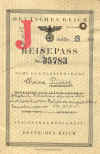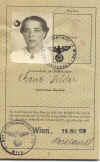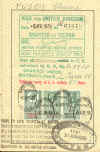



At the time of the Nazi takeover in 1933, there were over 500,000 Jews in Germany. Initially, the Nazis encouraged emigration and placed few restrictions on the amount of property Jews could take with them. Over time, however, the German government imposed ever increasing emigration taxes and restrictions on the amount of money which could be transferred abroad from Germany. By November, 1938, about 150,000 Jews (30% of the original population) had left Germany. After Kristallnacht, an additional 150,000 left. The following table from the Encyclopedia Judaica details the countries to which these Jews emigrated:
| United States | 63,000 |
| Palestine | 55,000 |
| Great Britain | 40,000 |
| France | 30,000 |
| Argentina | 25,000 |
| Brazil | 13,000 |
| South Africa | 5,500 |
| Italy | 5,000 |
| Other European Countries | 25,000 |
| Other South American Countries | 20,000 |
| Far Eastern Countries | 15,000 |
| Other | 8,000 |
| Total | 304,500 |
Examples
The first example is a passport issued in Vienna on October 19, 1938, to a Chaune Puder. Notice that this passport was issued prior to the date that the name "Sara" had to be included in the names of Jewish women. On April 6, 1939, she was granted a visa in Vienna for the United Kingdom. On May 17, 1939, she was granted a transit visa from the Belgian Counsel in Vienna. She arrived in Belgium on June 6, 1939, and landed in Dover, England on June 11, 1939. Below are thumbnails of pages from the passport. The first thumbnail is the first page from the passport with the red "J" for Juden. The second thumbnail is page 2 of the passport with the picture of Ms. Puder. The third thumbnail is page 8 of the passport with the Belgian transit visa. The final thumbnail is page 9 of the passport with the visa from the United Kingdom. Please click on the thumbnail to see the full image, and then click your back key or "Example 1" in the left frame to return.
Example 2 is a "Fremdenpass" issued in Vienna to Beila Herzbaum on March 24, 1939. A Fremdenpass was a German passport issued to certain residents of German protectorates. These individuals did not have nationality and were unable to qualify for German citizenship. In order to obtain this status, the individual needed certain skills which were valuable to the Germans. Beila was able to obtain a visa to Palestine with a transit visa through Italy. Below are thumbnails of pages from the passport. The first thumbnail is the first page from the passport with the red "J" for Juden. The second thumbnail is pages 2 and 3 of the passport with the picture of Beila. The third thumbnail is page 9 of the passport which contains the visa to Palestine issued on March 31, 1939. The fourth thumbnail is page 10 of the passport containing the transit visa issued by the Italian counsel in Vienna on April 13, 1939, for transit through Trieste. The final thumbnail is the Palestine immigration status issued in Tel-Aviv on April 28, 1939. Please click on the thumbnail to see the full image, and then click your back key or "Example 2" in the left frame to return.
Example 3 is a passport issued in Vienna on June 2, 1939, to a Emilie Cylinder. In contrast to the passport issued to Chaune Puder above, the passport issued to Emilie required the inclusion of the name "Sara". On December 8, 1939, she was granted a visa in Vienna for Argentina, and she was also able to obtain a transit visa through Italy. She arrived in Italy on January 13, 1940, and sailed on the next day from Trieste on the M/N Neptunia. She arrived in Argentina on February 3, 1940. Below are thumbnails of pages from the passport. The first thumbnail is the first page from the passport with the red "J" for Juden. The second thumbnail is page 2 of the passport with the picture of Ms. Cylinder. The third thumbnail is page 9 of the passport with the visa from Argentina. The fourth thumbnail is page 11 of the passport with the transit visa from the Italy. Although the Italian Consulate included "Sara" in her name on the transit visa, it does does not appear that there was any requirement for such inclusion. The fifth thumbnail is the German Police permit allowing her to leave. The final thumbnail is page 32 of the passport bearing the Italian stamp showing departure on the M/N Neptunia. Please click on the thumbnail to see the full image, and then click your back key or "Example 3" in the left frame to return.
Example 4 consists of five covers tracing the journey of Heinz Goldberg from Berlin to safety in Shanghai. The covers are from his mother in Berlin. The first cover, dated April 15, 1939, is from Berlin to Bombay, addressed to Heinz on the ship Cto. Rosso. The second cover, dated April 19, 1939, is from Berlin to Colombo, Ceylon, addressed to Heinz on the ship Cto. Rosso. The third cover, dated April 22, 1939, is from Berlin to Hong Kong, addressed to Heinz on the ship Cto. Rosso. The fourth cover, dated June 18, 1940 to Heinz in c/o Gottschalk in Shanghai. The last cover is addressed to Heinz at his own address in Shangahi. About 20,000 Jews found shelter in Japanese occupied Shanghai between 1938 and 1941. After the end of the war, these Jews left for other parts of the world. Please click on the thumbnail to see the full image, and then click your back key or "Example 4" in the left frame to return.
Example 5 is a postcard dated November 17, 1939 from Prague to the ship Saturnus which was located at a port in Yugoslovia. The Saturnus had left in November, 1939, from Bratislava with a load of Jews from Prague. The ship broke down in the waters off Yugoslovia. The card is to a passenger on the ship from relatives. The group on the ship made it to Sulina on the Black Sea. Please click on the thumbnail to see the full image, and then click your back key or "Example 5" in the left frame to return.
Example 6 is a declaration of a Jewish woman who was fortunate enough to obtain a Brazilian Visa and leave Germany in 1936. The purpose of the declaration before the British Counsel in Sao Paulo was to obtain the release of funds held for her in Palestine. Please click on the thumbnail to see the full image, and then click your back key or "Example 6" in the left frame to return.
Example 7 is letter from the Reicsvereinigung der Juden in Essen which was the agency that arranged emigration. This letter is dated November 3, 1941, and addressed to a Mr. Berg in Chicago, who had been attempting to help a Jenny Lowenstein emigrate to Cuba. It appears that she had been deported to the east, and it was too late to help. Please click on the thumbnail to see the full image, and then click your back key or "Example 7" in the left frame to return.
Example 8 consists of two items. The first item is a letter dated September 21, 1939, from the Uruguay Legation in Warsaw indicating that the legation was in the charge of a Mrs. Ciechanow. This no doubt gave Mrs. Ciechanow and her husband some protection under the Nazi occupation. The second item is a letter dated March 29, 1940, from the Bolivian Counsel in Zurich to the Swiss Police to the effect that Mr. Ciechanaow was employed by the Consulate. These letters show how some people with money were able to buy their way out of German controlled areas. Please click on the thumbnail to see the full image, and then click your back key or "Example 8" in the left frame to return.
Example 9 deals with attempts by Jews to get to Palestine by boat. In July, 1939, a number of Jews of Bratislava, Czechoslovakia were allowed to leave the country on forged Liberian passports. Each person had to pay about $10,000 for passage on a Hungarian ship to Palestine. The ship was not there when they arrived in Sulina, Rumania for departure. They were able to bribe their way on a Greek coal ship, the Noemi Julia, which was going to Palestine. Over 3,000 persons were crammed on the ship. The British noticed the ship near Istanbul and radioed that it would not be allowed to enter Palestine. The Jewish leader on board, Julius Koenig, radioed the Jewish Council in Istanbul to send food, water and medicine. Since the War had just started, the Turks did not want to release the supplies. Finally, the supplies were delivered as evidenced by a telegram to the ship from Mr. Ginzburg, the President of the Jewish community in Istanbul. The ship was finally allowed into Palestine. It was the last during the War. The first thumbnail is a copy of the notice from the Jewish Council in Bratislava regarding the place and conditions of embarkation. The second and third thumbnails are the front and back of the telegram to the ship from Mr.Ginzburg. Please click on the thumbnail to see the full image, and then click your back key or "Example 9" in the left frame to return.
Example 10 consists of the front and back of two postcards from the M/S St. Louis postmarked Cuxhaven on August 16, 1932, and Hamburg on August 11, 1934, depicting the ship in New York harbor and the smoking parlor. Special HAPAG cruise cachets are applied to each card, This ship is famous for its ill fated attempt to bring 930 Jewish refugees to Cuba. For more information on this trip see http://www.jewishvirtuallibrary.org/jsource/Holocaust/stlouis.html and http://www1.ushmm.org/wlc/article.php?lang=en&ModuleId=10005267. Please click on the thumbnail to see the full image, and then click your back key or "Example 10" in the left frame to return.
Example 11 is a German Kinderausweis Identity Card issued to a ten year old Jewish boy, Josef Baruch Stub in Mainz on December 9, 1938. The card contains a red "J" hand stamp for Juden. Josef traveled through Italy to Palestine and was granted permanent residence there on February 27, 1939. Please click on the thumbnail to see the full image, and then click your back key or "Example 11" in the left frame to return.
Example 12 is a Heimatschein form which was a document allowing a one year temporary stay outside of Germany. This document was issued on June 8, 1939, in Stuttgart, to a Jew, Moritz Kaufmann, his wife and seventeen year old daughter. Please click on the thumbnail to see the full image, and then click your back key or "Example 12" in the left frame to return.
Example 13 is a telegram sent on June 23, 1943, from Basel, Switzerland, to Jerusalem, received on June 25, 1943. The sender was Dr. Tadeus Reichstein, the Director of the Pharmaceutical Institute at the University of Basel. In 1950, he was the recipient of the Nobel Prize in Physiology of Medicine. The telegram was sent to Professor Bernard Zondak at the Hadassah Hospital in Jereusalem. Zondek had studied in Berlin, and in 1929, he became the head of the department of obstetrics and gynecology at the municipal hospital of Berlin-Spandau. In 1933, he was dismissed by the Nazis from his post, and he emigrated to Stockholm. He moved to Jerusalem in 1940, and in 1953 was awarded the Israel Prize in Medicine. In the telegram, Reichstein urges Zondek to contact Eliyahu Dobkin, the head of the Jewish Agency's Immigration Department during World War II, to obtain "veteran" certficates of immigration for Professor Ernst Laquer, Felix Oestereicher, and Paul Goldschmidt and their respective families. "Veteran" Zionists were given priority in the issuance of immigration certficates by the Jewish Agency. For a comprehensive discussion of the immigration policies of the Jewish Agency in Palestine during the war, see Tom Segev, Seventh Million: The Israelis and the Holocaust (1993). Please click on the thumbnail to see the full image, and then click your back key or "Example 13" in the left frame to return.
Encyclopedia Judaica, CD-Rom Edition, Keter Publishing
Kristallnacht Information on the Web
Dawidowicz, The War Against the Jews 1933-45, P. 189-91
United States Holocaust Memorial Museum, Historical Atlas of the Holocaust, P. 25-27
Ray & Josephine Cowdery, Papers Please!, P. 101-02
http://nobelprize.org/medicine/laureates/1950/reichstein-bio.html
http://www.whonamedit.com/doctor.cfm/1717.html
Copyright © 2001 Edward Victor